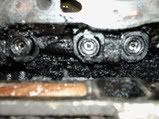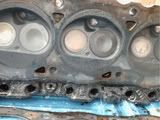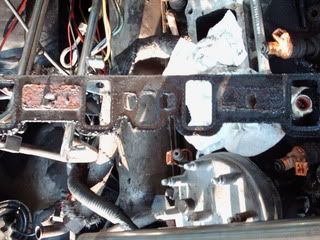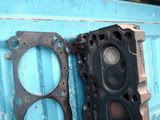Coolant overflow...but found problem, I believe..
#1
Coolant overflow...but found problem, I believe..
I've had a coolant overflow problem since I got the truck. I already replaced the rad, the thermostat, the water pump, and did 3 cooling system flushes. I did many searches on this and have come to a conclusion after some shadetree testing.
On my '92, F-150, 302, AOD tranny, 4x4, I did the air in the Spark plug trick and found on the number 5 cylinder that after adding air to it and leaving it there, the coolant started to rise and then continue and then started to go run into the resevior tank. Am I correct to say that I have a blown gasket? If so I couldn't believe how well it did on the compression test @ 160lbs. The worst cylinder was #8 with 120.
#5 160
#6 155
#7 160
#8 120
#1 145
#2 150
#3 150
#4 145
From looking at the chilton and Haynes manuals, the repair looks straightforward. I was gonna do a complete gasket set. Anyone have any tips, tricks or hints for me. I just dont want to pay a shop for something I can do here at home.
On my '92, F-150, 302, AOD tranny, 4x4, I did the air in the Spark plug trick and found on the number 5 cylinder that after adding air to it and leaving it there, the coolant started to rise and then continue and then started to go run into the resevior tank. Am I correct to say that I have a blown gasket? If so I couldn't believe how well it did on the compression test @ 160lbs. The worst cylinder was #8 with 120.
#5 160
#6 155
#7 160
#8 120
#1 145
#2 150
#3 150
#4 145
From looking at the chilton and Haynes manuals, the repair looks straightforward. I was gonna do a complete gasket set. Anyone have any tips, tricks or hints for me. I just dont want to pay a shop for something I can do here at home.
#2
#3
Probably is a gasket.
My generic answer is...
This is not a hard job to do unless space is tight. When you remove the heads, you should double check to see if there are clues that the gasket is blown, like water/rust trails on the block deck or head. obvious bad gasket etc. If you don't see anything obvious take a peek down the cylinder bore to see if there is anything like a crack there. That is a bigger problem but can be fixed, sleeved.
Get a good brand gasket, some good sealer, I like copper gasket sealer. I think permatex or someone makes a nice spray on copper seal. Looks like spray paint.
BEFORE you tear things apart take a picture or two and get some of those tape number markers from a office supply. Wrap numbers around wires or anything you might forget where it plugs in. Makes reassembly less guess work.
While the heads are off, you might consider a valve job. If your engine ie old and kind of loose, a vavle job might put extra wear on the rings and bearings, but usually not a problem unless things are really worn out.
BTW # 8 looks kind of low. You might want to determine why that is low. A quickie test is to squirt about a table spoon of motor oil into the cylinder and check if the compression goes up = rings, not up = usually valve guides or gasket. Interesting that #5 is relatively high. usually a bad head gasket has neighbor cylinders both low. But could be a leak somewhere else.
hmmm, As I think of it, #8 low and #5 high is confusing. You sure you got the right numbers as being leaky? Almost makes me think #5 might have a leak in the head to a water jacket.
How fast did the water level rise and did you notice if the pressure in #5 went down?
Good Luck,
Jim Henderson
My generic answer is...
This is not a hard job to do unless space is tight. When you remove the heads, you should double check to see if there are clues that the gasket is blown, like water/rust trails on the block deck or head. obvious bad gasket etc. If you don't see anything obvious take a peek down the cylinder bore to see if there is anything like a crack there. That is a bigger problem but can be fixed, sleeved.
Get a good brand gasket, some good sealer, I like copper gasket sealer. I think permatex or someone makes a nice spray on copper seal. Looks like spray paint.
BEFORE you tear things apart take a picture or two and get some of those tape number markers from a office supply. Wrap numbers around wires or anything you might forget where it plugs in. Makes reassembly less guess work.
While the heads are off, you might consider a valve job. If your engine ie old and kind of loose, a vavle job might put extra wear on the rings and bearings, but usually not a problem unless things are really worn out.
BTW # 8 looks kind of low. You might want to determine why that is low. A quickie test is to squirt about a table spoon of motor oil into the cylinder and check if the compression goes up = rings, not up = usually valve guides or gasket. Interesting that #5 is relatively high. usually a bad head gasket has neighbor cylinders both low. But could be a leak somewhere else.
hmmm, As I think of it, #8 low and #5 high is confusing. You sure you got the right numbers as being leaky? Almost makes me think #5 might have a leak in the head to a water jacket.
How fast did the water level rise and did you notice if the pressure in #5 went down?
Good Luck,
Jim Henderson
#4
Thanks so much for the reply Jim! Yes, #5 is the closest cylinder to the front of the engine. It held 160, and #8 was the farthest back to the fenderwall on the driver side. It was 119, 120, but when I added oil to it, it went back up to 155-160.
I would have to compression test the #5 again to check leak down but I didn't really follow long enough for leak down. I was just checking for head gaskets but didn't see where one of them was down below the 100's.
AS far as the valve job, I thought about it, but there is a main bearing knock on startup and there was terrible sludge in the oil pan when I pulled the timing cover to replace timing seal. The ol' truck is a bit on the loose side.
"Almost makes me think #5 might have a leak in the head to a water jacket." Does this mean that the head has a crack in it? The water started to rise very slowly and continued until I disconnected the air line. It never dropped down, added the air line again and continued to rise until it rose up and started dumping into the resevior line.
If you agree on a gasket being blown, I will start tearing down the driver side, since the valve cover also leaks a bit on that side as well. I can drop the head off at Carquest here and let them clean and inspect it.
Well, gotta head off to work. Will check back tomorrow morning! Thanks again Jim!
I would have to compression test the #5 again to check leak down but I didn't really follow long enough for leak down. I was just checking for head gaskets but didn't see where one of them was down below the 100's.
AS far as the valve job, I thought about it, but there is a main bearing knock on startup and there was terrible sludge in the oil pan when I pulled the timing cover to replace timing seal. The ol' truck is a bit on the loose side.
"Almost makes me think #5 might have a leak in the head to a water jacket." Does this mean that the head has a crack in it? The water started to rise very slowly and continued until I disconnected the air line. It never dropped down, added the air line again and continued to rise until it rose up and started dumping into the resevior line.
If you agree on a gasket being blown, I will start tearing down the driver side, since the valve cover also leaks a bit on that side as well. I can drop the head off at Carquest here and let them clean and inspect it.
Well, gotta head off to work. Will check back tomorrow morning! Thanks again Jim!
Last edited by timbersteel; 08-16-2010 at 06:17 PM. Reason: Double typed paragragh
#5
Most auto parts stores such as Autozone, Advance Auto etc.. will rent you a radiator pressure tester kit. You put a deposit down and when you return the kit they will return the deposit.
You install the proper radiator cap from the kit and use the hand held pump to pressurize the cooling system to 1 or 2 lbs. above the pressure marked on your original radiator cap. If the cooling system has a leak the gauge reading will start dropping.
Hard to tell if your test was valid. How did you determine that both the intake and exhaust valve on cylinder five were closed when you pressurized the cylinder?
You say you've had a coolant overflow problem since you have owned the truck.
Are you sure the proper radiator cap is installed?
Have you verified the fan clutch is working?
Notice any of the spark plug electrodes have a wet look which would indicate coolant being burned in that cylinder?
You install the proper radiator cap from the kit and use the hand held pump to pressurize the cooling system to 1 or 2 lbs. above the pressure marked on your original radiator cap. If the cooling system has a leak the gauge reading will start dropping.
Hard to tell if your test was valid. How did you determine that both the intake and exhaust valve on cylinder five were closed when you pressurized the cylinder?
You say you've had a coolant overflow problem since you have owned the truck.
Are you sure the proper radiator cap is installed?
Have you verified the fan clutch is working?
Notice any of the spark plug electrodes have a wet look which would indicate coolant being burned in that cylinder?
#6
Most auto parts stores such as Autozone, Advance Auto etc.. will rent you a radiator pressure tester kit. You put a deposit down and when you return the kit they will return the deposit.
You install the proper radiator cap from the kit and use the hand held pump to pressurize the cooling system to 1 or 2 lbs. above the pressure marked on your original radiator cap. If the cooling system has a leak the gauge reading will start dropping.
Hard to tell if your test was valid. How did you determine that both the intake and exhaust valve on cylinder five were closed when you pressurized the cylinder?
You say you've had a coolant overflow problem since you have owned the truck.
Are you sure the proper radiator cap is installed?
Have you verified the fan clutch is working?
Notice any of the spark plug electrodes have a wet look which would indicate coolant being burned in that cylinder?
You install the proper radiator cap from the kit and use the hand held pump to pressurize the cooling system to 1 or 2 lbs. above the pressure marked on your original radiator cap. If the cooling system has a leak the gauge reading will start dropping.
Hard to tell if your test was valid. How did you determine that both the intake and exhaust valve on cylinder five were closed when you pressurized the cylinder?
You say you've had a coolant overflow problem since you have owned the truck.
Are you sure the proper radiator cap is installed?
Have you verified the fan clutch is working?
Notice any of the spark plug electrodes have a wet look which would indicate coolant being burned in that cylinder?

#7
Thanks for the replies! I did forget to mention that I installed a new Motocraft radiator cap. Brand new fan clutch, checked for resistance, new water pump. When I got the truck it had a reddish, brown color with a nasty smell to it. I installed a flush kit and flushed it 3 times and at different RPM's and back to idle, sometimes for 20 to 30 mins a flush.
Plugs on #5,#7, #8 look wet and I have verified this 3 diferent times while pulling plugs and installing new ones and doing a compression test.
I can't say for sure about knowing if i had #5 at TDC, but when I started with #8, I had air coming out the intake, #7 was exhaust, #6 neither I could hear, and #5 is when the coolant started to rise.
The truck never shows signs of running hot. The only time it begins it fit, is when I start driving highway speed and doing passing and slowing down. then I've lost nearly 3 quarts in a 40 mile round trip. The hose will pressure fine while idling, but after really getting the block hot and driving is when it starts. It will also start blowing a bluish somewhat greyish exhaust, untill I get to driving it for a few minutes and then it will go away.
Let me know what you guys think.
Plugs on #5,#7, #8 look wet and I have verified this 3 diferent times while pulling plugs and installing new ones and doing a compression test.
I can't say for sure about knowing if i had #5 at TDC, but when I started with #8, I had air coming out the intake, #7 was exhaust, #6 neither I could hear, and #5 is when the coolant started to rise.
The truck never shows signs of running hot. The only time it begins it fit, is when I start driving highway speed and doing passing and slowing down. then I've lost nearly 3 quarts in a 40 mile round trip. The hose will pressure fine while idling, but after really getting the block hot and driving is when it starts. It will also start blowing a bluish somewhat greyish exhaust, untill I get to driving it for a few minutes and then it will go away.
Let me know what you guys think.
Trending Topics
#8
From your information it appears the engine over heated and the prior owner
kept driving the vehicle. He or she dumped some chemical stop leak into the cooling system to plug the coolant leak.
That could explain the strange smell (if it's not a anti freeze smell) and why the head gasket appears to be blown.
The wet plugs indicate coolant is leaking into the cylinders you mentioned.
Could be blown head gasket, cracked head, or block.
If you drain the oil and find antifreeze in it, the engine bearings could also be
damaged which would explain the knocking sound on start up.
The radiator pressure tester should easily detect a problem if you're losing 3 quarts of coolant in 40 miles of driving.
You could also try this. Remove the fuel pump relay to disable the fuel pump. Place a rag around the fuel rail schrader valve. Press on the fuel rail schrader valve to relieve any pressure in the fuel rail. With all of the spark plugs removed, pressurize the coolant system. Let it sit that way for 30 minutes. Have some one crank the engine or use a remove starter switch.
If there is coolant in any cylinder, coolant will spit out of the spark plug hole.
kept driving the vehicle. He or she dumped some chemical stop leak into the cooling system to plug the coolant leak.
That could explain the strange smell (if it's not a anti freeze smell) and why the head gasket appears to be blown.
The wet plugs indicate coolant is leaking into the cylinders you mentioned.
Could be blown head gasket, cracked head, or block.
If you drain the oil and find antifreeze in it, the engine bearings could also be
damaged which would explain the knocking sound on start up.
The radiator pressure tester should easily detect a problem if you're losing 3 quarts of coolant in 40 miles of driving.
You could also try this. Remove the fuel pump relay to disable the fuel pump. Place a rag around the fuel rail schrader valve. Press on the fuel rail schrader valve to relieve any pressure in the fuel rail. With all of the spark plugs removed, pressurize the coolant system. Let it sit that way for 30 minutes. Have some one crank the engine or use a remove starter switch.
If there is coolant in any cylinder, coolant will spit out of the spark plug hole.
#9
Well, I can't seem to find a parts store close to here that loans the rad and cap tester. Nearest one is 34 miles away. I'll have to see what I can do.
When I change oil, there's no visible coolant mixed with the oil and with the compression readings, that is what has me stumped??? Well, Murphy's Law....
I'll post back when I can come up with something.
Thanks for the ideas and help. I'll try to get back soon!
When I change oil, there's no visible coolant mixed with the oil and with the compression readings, that is what has me stumped??? Well, Murphy's Law....
I'll post back when I can come up with something.
Thanks for the ideas and help. I'll try to get back soon!
#10
Yeah it is starting to sound a bit more like at least a bad head gasket or crack in the block or head.
The check for water spraying out during cranking sounds like a good trick, once you get a pressure test kit.
Since you probably will ahve to remove the heads to do whatever fix is needed, you should definitely check for cracks and be ready for some unpleasant news. WHen you take the heads in, have them checked for cracks. No use having them done if they are bad.
Sounds like this engine has seen too many miles and a bit of abuse.
Good Luck,
Jim Henderson
The check for water spraying out during cranking sounds like a good trick, once you get a pressure test kit.
Since you probably will ahve to remove the heads to do whatever fix is needed, you should definitely check for cracks and be ready for some unpleasant news. WHen you take the heads in, have them checked for cracks. No use having them done if they are bad.
Sounds like this engine has seen too many miles and a bit of abuse.
Good Luck,
Jim Henderson
#11
Here's some pics of a complete, poor maintained engine. Just another reason you SHOULD change oil on a schedule and always pay close attention to the CHECK ENGINE LIGHT!




On the front part of the head gasket, I noticed that of the "2" water jackets, "1" had a 3/16 hole for the jacket, but the other water jacket for the head was completely blocked off, but there was coolant in the water jacket in the block for that particular one. The lower end of the head gasket was completely open as "IT" would appear to be, but cannot understand why the front water jacket's wer partially and completely closed off.
The lower intake gasket you could see had rust on the one part of it closet to #5 and #6 cylinder. guess I'll have more to look at tomorrow.
Also noticed that 6 out of 8 injectors had visible harline cracks around the spraying end of the injector. Should I replace since i have them out?
Sorry for the big pics..I know it makes it hard on the servers. I hope this doesn't inconvience anyone.




On the front part of the head gasket, I noticed that of the "2" water jackets, "1" had a 3/16 hole for the jacket, but the other water jacket for the head was completely blocked off, but there was coolant in the water jacket in the block for that particular one. The lower end of the head gasket was completely open as "IT" would appear to be, but cannot understand why the front water jacket's wer partially and completely closed off.
The lower intake gasket you could see had rust on the one part of it closet to #5 and #6 cylinder. guess I'll have more to look at tomorrow.
Also noticed that 6 out of 8 injectors had visible harline cracks around the spraying end of the injector. Should I replace since i have them out?
Sorry for the big pics..I know it makes it hard on the servers. I hope this doesn't inconvience anyone.
Last edited by timbersteel; 08-19-2010 at 02:13 AM. Reason: Pics to large
Thread
Thread Starter
Forum
Replies
Last Post
TexinCali
1973 - 1979 F-100 & Larger F-Series Trucks
25
07-28-2014 06:22 PM
diesellou86
Ford Inline Six, 200, 250, 4.9L / 300
10
04-17-2012 09:29 AM
Betsy98Sport
Explorer, Sport Trac, Mountaineer & Aviator
1
09-05-2010 05:32 PM
rich51fordtruck
1973 - 1979 F-100 & Larger F-Series Trucks
3
02-13-2009 10:54 PM



